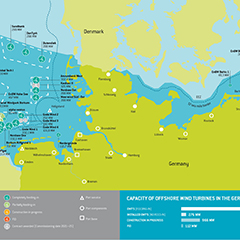- Total of 1,305 turbines with 6,382 MW connected to the grid | 136 turbines with almost 1 GW new in the grid | 966 MW under construction
- Offshore wind power generation rises again significantly by around eight percent
- Special tender of at least 1,500 MW required in the first quarter of 2019
- Expansion volume has to be legally determined to at least 20 GW by 2030
Berlin, 21 January 2019 – Today in Berlin, the most important industry associations presented the current figures for offshore wind energy in Germany for the year 2018. Their core message is: “2019 must be the year of progress in energy policy. Offshore wind energy is of central importance for the achievement of climate protection targets and secures value creation in Germany as an industrial player”. They added: “Power production from offshore wind increased by around eight percent in 2018 while costs declined, thus contributing to a stable, low-cost and clean electricity supply. With this balance and the correct and urgently needed initiative by Minister Altmaier to expand the grid, the preconditions are met for a faster expansion”, said the industry representatives of BWE, BWO, Stiftung OFFSHORE-WINDENERGIE, VDMA Power Systems and WAB.
Expansion according to plan – sector with positive balance
According to the latest figures published by Deutsche WindGuard, 1,305 offshore wind turbines with a total output of 6,382 MW (megawatts) fed into the grid in 2018. In this period, 136 new turbines with an output of 969 MW were connected to the grid. This confirms the forecast made last year by the industry associations. In addition, 276 MW were fully installed but have not yet fed into the grid. Furthermore, a capacity of 966 MW is currently under construction. The final investment decision has been made for another 112 MW. The legally permitted expansion of 7.7 GW (gigawatts) by 2020 will therefore probably be achieved as planned.
Raise expansion targets to at least 20 GW by 2030
The current political conditions are slowing down the further positive development of offshore wind energy in Germany. According to the coalition agreement, 65 percent of German power production is to be generated from renewable energy sources by 2030, which, however, cannot be achieved with the currently planned expansion. This was also emphasised by the call of industry and federal states to federal policy, recently at WindEnergy in Hamburg, whose statement was again underlined at today’s press conference: “In order to contribute to achieving the goals of the coalition agreement, the offshore wind industry needs to expand to at least 20 GW by 2030 and at least 30 GW by 2035. The Energy Policy Agenda 2019 offers the opportunity to make forward-looking decisions this year and to complete the missing statements on offshore wind in the Omnibus Energy Act,” said the industry representatives.


























